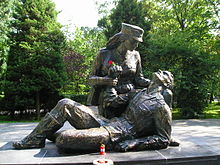- Military medicine
-
The term military medicine has a number of potential connotations. It may mean:
- A medical specialty, specifically a branch of occupational medicine attending to the medical risks and needs (both preventive and interventional) of soldiers, sailors and other service members. This disparate arena has historically involved the prevention and treatment of infectious diseases (especially tropical diseases), and, in the 20th Century, the ergonomics and health effects of operating military-specific machines and equipment such as submarines, tanks, helicopters and airplanes. Undersea and aviation medicine can be understood as subspecialties of military medicine, or in any case originated as such. (The American Board of Medical Specialties does not, however, certify or recognize a specialty or subspecialty of “military medicine”.)
- The planning and practice of the surgical management of mass battlefield casualties and the logistical and administrative considerations of establishing and operating combat support hospitals. This involves military medical hierarchies, especially the organization of structured medical command and administrative systems that interact with and support deployed combat units. (See Battlefield medicine.)
- The administration and practice of health care for military service members and their dependents in non-deployed (peacetime) settings. This may (as in the United States) consist of a medical system paralleling all the medical specialties and sub-specialties that exist in the civilian sector. (See also Veterans Health Administration which serves U.S. veterans.)
- Medical research and development specifically bearing upon problems of military medical interest. Historically, this encompasses all of the medical advances emerging from medical research efforts directed at addressing the problems encountered by deployed military forces (e.g., vaccines or drugs for soldiers, medical evacuation systems, drinking water chlorination, etc) many of which ultimately prove important beyond the purely military considerations that inspired them.
Contents
Historical significance
The significance of military medicine for combat strength can be judged based on the fact that in every single major war fought until the late 19th century disease claimed more soldier casualties than did enemy action. During the American Civil War (1860-65), for example, about twice as many soldiers died of disease as were killed or mortally wounded in combat[1]. The Franco-Prussian War (1870-71) is considered to have been the first conflict in which this ratio was reversed, at least in the German coalition army which lost 3.47% of its average headcount to combat and only 1.82% to disease[2]. In new world countries, such as Australia, the United States and Canada, military physicians and surgeons contributed significantly to the development of civilian health care.[3]
Military medicine by country
See also
- Triage
- Field hospital
- MEDEVAC
- CASEVAC
- Medical corps
- Medical Service Corps
- Military nurse
- Military medical ethics
- Military psychiatrist/Military psychiatry
- History of Military Nutrition
References
- ^ McPherson, James M. (1988). Battlecry of Freedom. Ballantine Books, New York. ISBN 0345359429., p. 485
- ^ Brockhaus' Konversations-Lexikon; 14th ed., Leipzig, Berlin and Vienna 1894; Vol. 8, p. 939.
- ^ Vivian Charles McAlister. "Origins of the Canadian School of Surgery" Canadian Journal of Surgery (2007) 50 (5) : 357-363. Available at: [1]
External links
U.S. military medicine
- Military Medicine related links from USAF Air University
- Association of Military Surgeons of the United States (AMSUS)
- Military Medicine Through Time. Life and Death in the War Zone | NOVA | PBS
- The Borden Institute Homepage
- Military Medicine Documents at USU Archive
- U.S. Army Preventive Medicine news archive from the 7th Infantry Division (Light) Panorama weekly newspaper 1988.
- Virtual Naval Hospital - a digital library of military medicine and humanitarian medicine
Australian military medicine
Historical military medicine
- "Medicine." The Pacific War Online Encyclopedia.
International Magazine for Military Medicine
- MCIF MEDICAL CORPS INTERNATIONAL FORUM International Magazine for Military Medicine
NATO Centre of Excellence for Military Medicine
Categories:- Military medicine
- Military supporting service occupations
- Military stubs
- Medicine stubs
Wikimedia Foundation. 2010.

